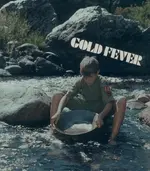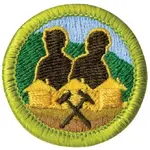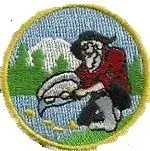Gold Fever – Boys’ Life Jun. 1975
By Vic Kondra
The "forty-niners," the people who traveled to California by the thousands
in 1849 to search for gold, have not been the only ones to experience
gold fever. ln the following reading selection, a contemporary group
of Boy Scouts on a camping trip to California gold rush territory finds that
panning for gold is a fascinating pastime.
Gold fever obviously had spread through the Scouts in Troop 121 of
Merced, California, and it grew stronger with each mile they trekked into
gold rush country. in their excitement, a few noticed how narrow the trail
became as it threaded its way along a five-hundred-foot sheer cliff above
the Merced River, once a magnet for thousands of gold seekers in the
mid-1800's.
At their destination the fifteen-member troop and five adult leaders
quickly made camp, held assembly, and raised the Stars and Stripes.
Shovels and pans were the order of the day as the group converged on
the river. Doug Boyster, one of the adult leaders, had considerable
experience gold panning so he was able to show the boys the most likely
spots. Pant legs rolled up and heads bowed, the scouts panned for those
elusive bits of bright yellow metal that in 1949 started one of the greatest
stampedes of treasure hunters the world has ever seen.
The ghosts of those old miners probably were chuckling in their beards
as they watched this excited group of young men in search of riches.
Gold fever really hit when Kevin Vance found a tiny flake of gold in the
bottom of his pan, but by late afternoon the fever cooled, and most of the
troop abandoned the search in favor of a swim in the river. only a few of
the more determined continued to dig and pan.
scoutmasters Art Hood and Bill Jackson later rounded up the swimmers
and took them on a tour of Hites cove, an area once rich in gold
and heavily populated with forty-niners in search of fortunes. Few found
gold; many were lucky even to survive. Most of the early gold seekers
worked under unbelievable hardships and were rewarded with little but
hunger and disease. often what little gold they did find was used to pay
their debts, spent quickly, or stolen from them. Few became rich in the
gold fields.
Traces of the gold rush period were all around troop 121's campsite.
Huge cast-iron and steel fixtures from an ore mill lay abandoned, and
parts of a giant steam engine were rusting away. Just above the camp,
columns made of flat sections of granite supported a roadbed along the
mountainside where mule-drawn cars had brought gold ore from somewhere
far upriver. Portions of buildings made from more of the granite
slabs were still standing. No mortar was used in the buildings, yet after
more than 120 years the walls remain upright.
The next morning the troop discovered a group of modern gold miners
hard at work about a mile upstream from the camp. Four men were
scouring the river with a floating dredge. ln the bottom of a deep pool a
scuba diver used a four-inch suction hose to extract gold-bearing gravel
and mud from the river bottom. The suctioned material was pumped to a
floating platform and through a sluice box l designed to wash away the
gravel and trap the gold. Despite eager questions, the four modern miners
declined to say how much gold they had found but did admit to taking
a few small nuggets,
It was not until the trip home that visions of a gold strike arose again.
One of the Scouts mentioned that winter snows and high water frequently
dislodge large pockets of nuggets and ore. That did it. Gold fever was
running high as plans were made for a spring trip back into Hites Cove.
This time they would definitely need more shovels, and maybe they
could build a sluice box and maybe rent a dredge. Just wait until next
year!
Boys' Life June 1975 - Google books
.









